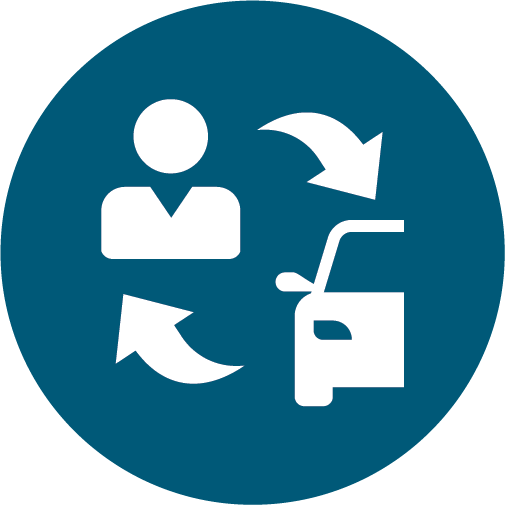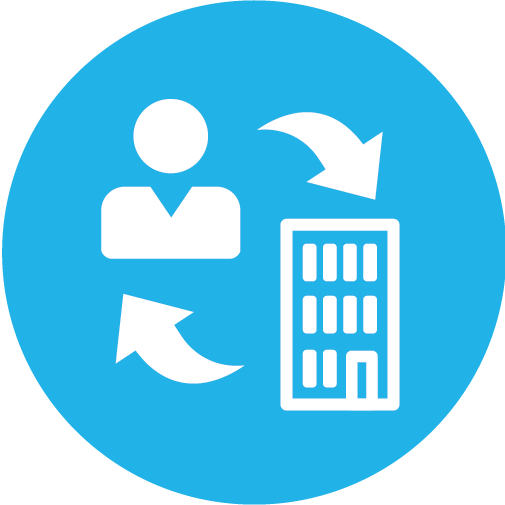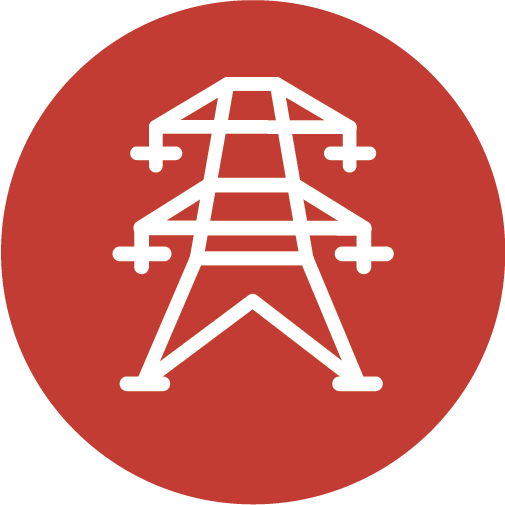Step 14 of the site-level federal fleet ZEV Ready process is to install and activate electric vehicle supply equipment (EVSE).
Navigate the ZEV Ready Process
| ZEV Active Phase Steps |
|---|
| 13. Acquire ZEVs and EVSE |
| 14. Install and activate EVSE |
| 15. Support drivers in using ZEVs and EVSE |
Return to the ZEV Ready Center to see all 15 steps.
Primary Audiences
 | Site ZEV Champions |
 | Site Location Fleet Managers |
 | Facility Infrastructure Managers |
 | Facility Energy Managers |
The site ZEV champion, site location fleet managers, facility infrastructure managers, local utility staff, and facility energy managers are the primary audiences for this process step.
After acquiring zero-emission vehicles (ZEVs) and EVSE, the site ZEV champion, site location fleet managers, facility infrastructure managers, and facility energy managers are responsible for managing and completing the EVSE installation process, including finalizing the EVSE site plan, determining and managing the need for electrical upgrades with the local utility, overseeing installation and activation of the EVSE, inspection, and verifying EVSE operation. The key site fleet stakeholders (typically the site location fleet manager) will also activate and set up accounts for users to access the chargers and create an EVSE maintenance plan.
EVSE Installation
As discussed in Step 13: Acquire ZEVs and EVSE, the key fleet stakeholders at the site location have finalized the EVSE installation specifications, which have been translated into a formal statement of work. The agency may install the EVSE themselves, hire a contractor, or have the General Services Administration Public Buildings Service manage installation. In all cases, EVSE installation typically follows a seven-step process. Each of these steps are explained in more detail below.
In Step 10: Complete Site Assessment and Design EVSE, the key fleet stakeholder at the site location completed a siting analysis to help choose the charging station locations, guide site designs, and evaluate power requirements. The site installation team or contractor’s first step in installing EVSE is to update and finalize the draft site plan or drawing. This final draft site plan should include details and diagrams of any excavation work that the site or contractor will do (e.g., trenching, concrete pouring) and how this work may affect operations at the facility.
In Step 9: Coordinate with Local Utility Service and Step 10: Complete Site Assessment and Design EVSE, the key fleet stakeholders have contacted the local electric utility representative and made a preliminary determination of whether the utility supply and equipment will be adequate to support the new EVSE based on the initial EVSE siting analysis. If the EVSE will draw power from the grid, the final draft plan should include the final determination of any electrical upgrades the site will need to make (in coordination with the local utility), such as upgraded distribution and transmission electric lines, upgraded service, or new meters. The facility infrastructure manager and energy managers, as well as environmental and safety staff, should actively participate in the creation of the final draft site plan.
After developing the site plan, the site or contractor should file an electrical work permit with the electrical authority having jurisdiction (AHJ). The permit is only required if the EVSE will draw power from the electric grid. The site or contractor must have permitted approval before conducting any electrical upgrades or installations. The AHJ is responsible for inspecting and approving all upgrades. When preparing permitting materials, the site or contractor should check to be sure which AHJ has responsibility for the facility, as requirements vary between jurisdictions. The site or contractor should also work closely with the AHJ to understand any inspections or processes that may be required.
The utility, working in conjunction with the AHJ, site, and contractor (if used), should make sure the electrical power supply can meet the increased demand from the EVSE. This is only required if the EVSE will draw power from the electric grid. It can take several months for the utility to determine whether new electrical service is required and then make the necessary upgrades. Therefore, it is important to contact the utility early in the process. Utility contact information and incentive programs can be found using the Utility Finder (U-Finder) tool.
After the utility has upgraded the power supply, the site or contractor should install the EVSE. The first step is to complete any excavation necessary to run electrical conduit. Before excavating, the site or contractor should work with facilities personnel and call “Before you dig” services to mark any underground electrical, gas, water, and sewage lines, or other underground objects (rebar, underground storage tanks). Then, the site or contractor should install any needed electrical upgrades, such as transformers, service panels, and meters. Next, the site or contractor should run conduit from the power supply to the EVSE installation site. Conduit protects the wires from the elements. Charging stations rated more than 60 amperes require a separate disconnect under the National Electrical Code (NEC 625.23), which should be installed while running conduit. Once the conduit has been installed and inspected, the site or contractor should pull wires through the conduit. Level 2 chargers require two hot lines, a neutral, and a ground.
Overcurrent protection (e.g., circuit breakers) should be sized to support 125% of the EVSE’s rated load (NEC 625.21). Next, the site or contractor should mount and install the charger. This may require upgrading the mounting surface (i.e., pouring a new concrete pad). The site or contractor should also make other site upgrades if necessary, such as protective bollards, improved lighting, and signage.
Once installation is complete, an independent inspector should verify that the EVSE meets all electric codes, as well as facility environmental and safety requirements. The inspector should check all installed equipment, including the EVSE, electrical panels, wiring, charger mounting, signage, and connections.
The site or contractor is responsible for resolving any issues identified by the inspector.
After the independent inspector has approved the installation, the site location fleet manager, facility infrastructure manager, and other key fleet stakeholders should verify the completion and operation of the installed EVSE.
Activate and Set Up EVSE Network Accounts
Different EVSE models have varying levels of networking capabilities. Basic models, often referred to as “dumb chargers,” have no networking capabilities. Most basic chargers do not have the capability to verify individual users for access and therefore, typically do not track usage or payments through user accounts. Basic chargers are generally cheaper to purchase and operate than networked charging stations.
Networked EVSE must have communication capabilities with the internet, site, and/or utility grid. Typically, user accounts, payments, and usage data are managed using an EVSE management system either provided with the EVSE or another provider. These systems verify access and support account management using radio-frequency identification cards, user IDs, or other methods, and process payments using authorization through the internet. They can be connected through cellular service separate from existing site information networks.
As part of EVSE installation services, the site or contractor will connect the charger to the network, followed by activation of the charger. The site fleet manager (or other key fleet stakeholders) will then enter individual user accounts for the vehicles that are provided with access to the charger in the EVSE management system. If the EVSE supports payments (e.g., through a web application or WEX fleet card), the EVSE management system will also support payment setup information.
Create EVSE Maintenance Plan
EVSE requires ongoing support in the form of inspections, routine preventive maintenance, and unscheduled maintenance. Fleet managers need to establish how EVSE will be managed after installation. Generally, this arrangement will consist of on-site personnel taking responsibility for low-level inspections and routine checks, and, if necessary, contractors taking responsibility for preventive and unscheduled maintenance. EVSE operations and maintenance services are also available on GSA's blanket purchase agreement for EVSE. The key fleet stakeholders at each site location need to determine what arrangement is best for their situation and develop the necessary contracts.
Previous Step
Go back to Step 13: Acquire ZEVs and EVSE.

